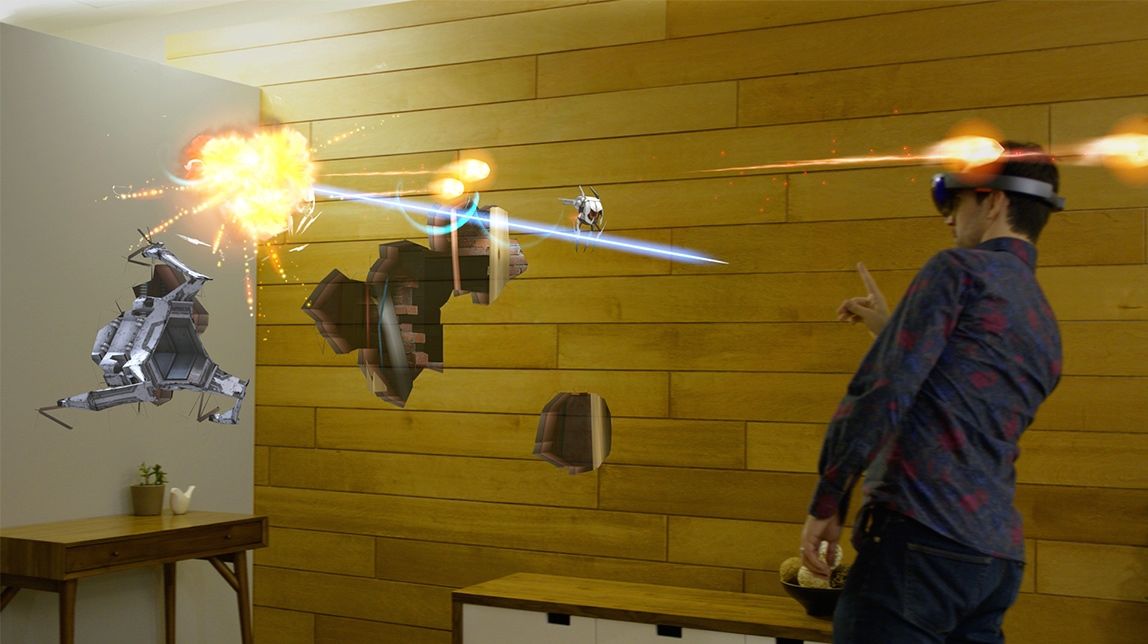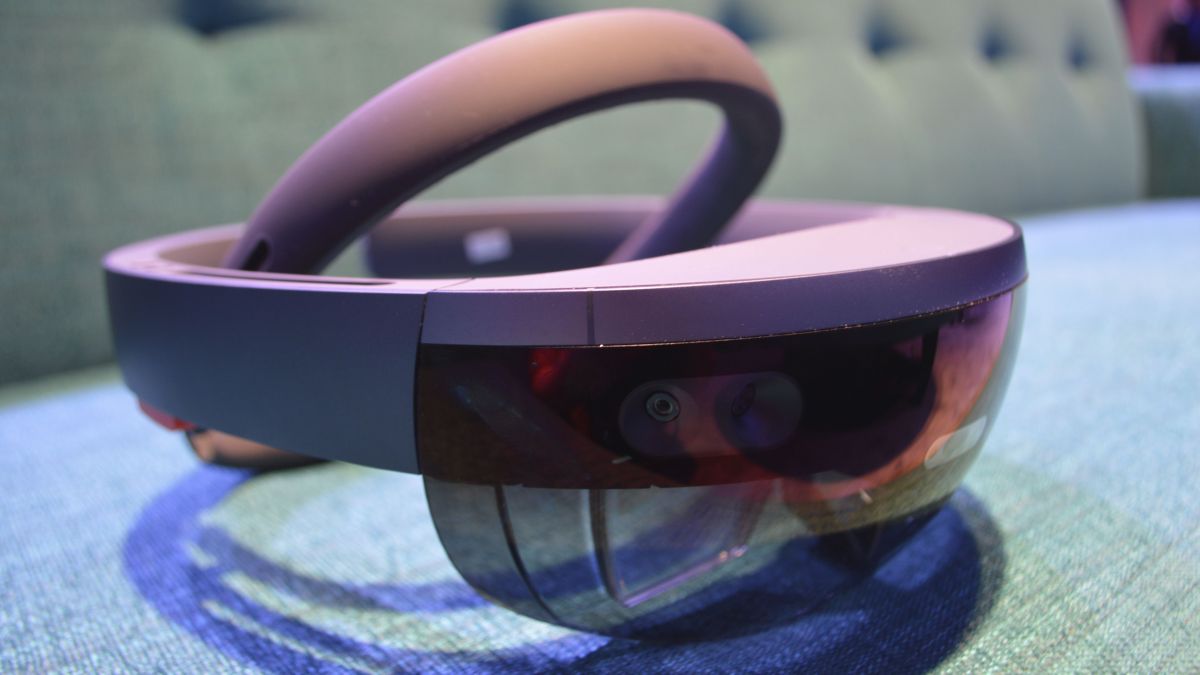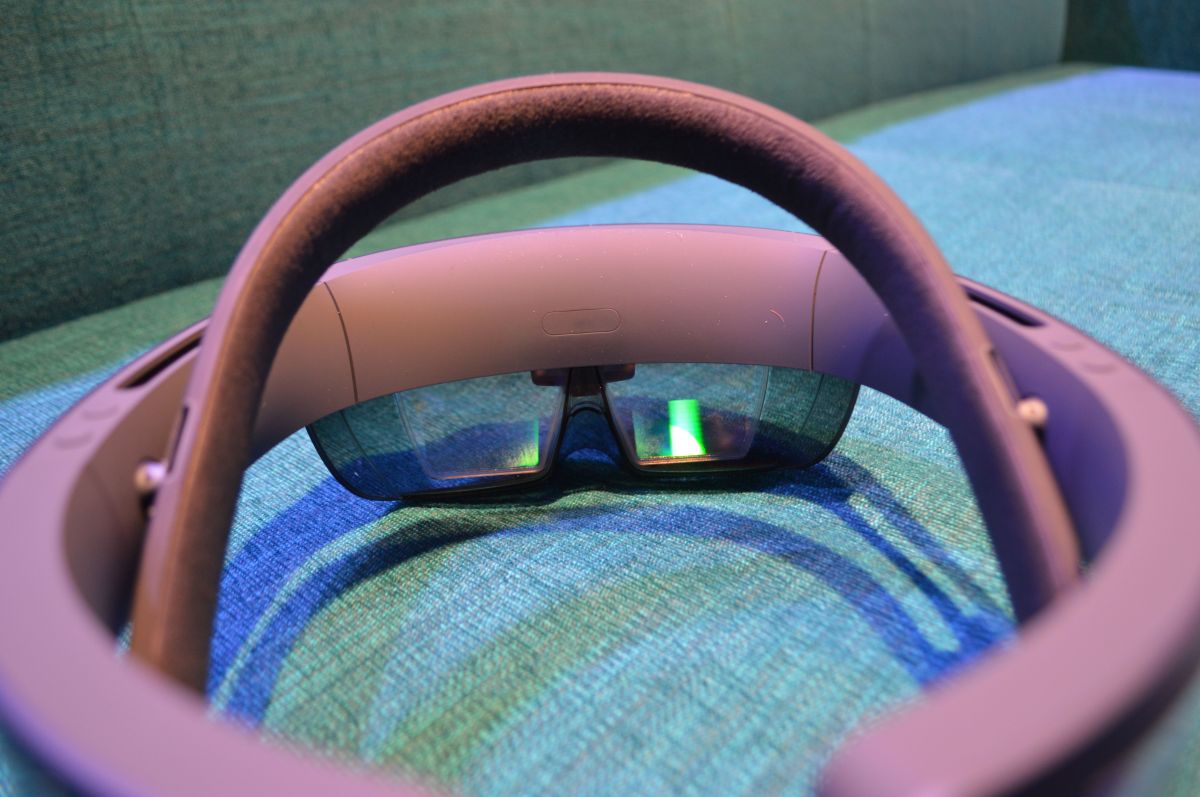
Page 1
Someone 10 feet away is pinching furiously at the air, aiming in my direction. To an observer not wearing Microsoft HoloLens, this person might look foolish, even bizarre.
Not to me. I’m pinching at him just as ardently, as well as five other people in a room of more than 50.
The initiated know we’re playing a game. Each of us has a demon-faced avatar called a Polly just above our shoulder, and the pinching motion – meeting index finger to thumb – sends fiery metal balls at our opponents’ avatars.
But, if we band together and shoot the balls at a blue orb floating over a metallic claw-like base that only the six of us can see, we can open up a hole in the floor (or table, or wherever) and attack an avatar located below.
My pod of players are all connected to the same computer, which is acting as a hub, allowing us to see each others’ color-coded Polly and the orb we need to destroy. Other groups have their own hub, so while we can see them milling around the room and pinching the air, we aren’t interacting with them. They aren’t in our game.
I can walk anywhere and still locate the players I need to shoot at thanks to their avatars. It’s like having robotic vision that allows you to see your “enemy” in a crowd that includes people who aren’t your targets, though in a much less sinister sense.
The blue orb and base serve as the focal point to our wanderings. We can even move this structure as a team if we circle around it, shift as a group and one of us sets it down with a pinching motion. Anyone can utter “Reset location” and the base will unlatch, letting us move it once again until another player selects a new spot for it.
It’s this simple, giddy game played at Build 2016 during my second-ever Holographic Academy that crystallized for me the awesome potential of HoloLens. Unlike Oculus Rift or HTC Vive, VR viewers that offer amazing immersion in unreal realms, Microsoft’s AR headset turns the world into your own augmented reality playground.

The power of reality
HoloLens, which began shipping to developers last week, is not a virtual reality headset that completely immerses you in a game or experience.
Instead, it overlays digital images onto the real world. You can still see everything in your environment, from couches to tables to computers to people, but if a HoloLens experience is activated, you’ll also see things that aren’t really there, like vibrant Pollys and prismatic shards as that blue orb is blown up.
HoloLens’ mixed reality induces a psychedelic feeling: I’d be having a perfectly normal conversation with my Holographic Academy mentor, but if I looked away or another player walked into my field of view, I’d see their bouncing Polly or the pulsating base. My mentor couldn’t see any of this because she wasn’t wearing HoloLens, but I could.
The other virtual reality headsets on the market transport you to other places, and all the major ones do this excellently in their own right. HTC Vive, as our Nick Pino describes in his hands-on review of the headset, is probably the best of them all at this.
HoloLens will take you to another planet, like Mars, but what I’ve found most intriguing during my time with the headset is that it adds magic to the real world. Any room can become something wonderful with mixed reality. Now, to make it even better, Microsoft is throwing in other people.
With most VR experiences I’ve tried, there’s a wall of sorts between myself and what I’m seeing, no matter how real it is, namely because I’m not actually in that world. That wall disintegrates wearing HoloLens.
All the world’s a stage, Shakespeare wrote. With HoloLens, all the world’s your play thing.
Page 2

No barriers
Microsoft said during my session that the No. 1 requested feature for the headset was sharing, and I think it’s on its way to making this one of the key selling points of HoloLens.
Anyone could potentially create a game or experience for HoloLens, then share it with others who own a headset, allowing everyone to interact not only with the augmented elements of the game but also with each other.
While Oculus Rift lets you meet other players’ avatars in virtual rooms and you can engage in multi-player games with anyone on the planet, HoloLens allows for true social interaction.
You can see and talk to players who are literally breathing the same air as you, seek them out, and rub it in their faces when you score a direct hit on their avatars.
One of HoloLens’ great pluses is its freedom of movement because you aren’t tethered to a PC, as is the case with every premium VR headset right now. My mentor said that in testing, they’ve found the holograms stay visible even down long hallways or in other rooms.
The in-house team really hasn’t hit on its distance limit yet, she said, meaning your HoloLens game could stretch as far as you wanted (though you’d likely need a Wi-Fi connection for the most robust experience).
It’s these two elements – seeing and interacting with real-world objects, including people, and being able to move around untethered – that, for me, give HoloLens an edge over its virtual reality competitors.
Don’t get me wrong, I’d still would love to own an Oculus Rift, and I can right now if I ordered one.
But, if someone forced me to pick, I’d choose HoloLens because, as a non-gamer, I see myself getting more use and enjoyment out of it through casual games, educational applications and generally being able to interact with the world while wearing it, rather than being a passive participant in a VR environment.

HoloLens hardware and hang-ups
The HoloLens Development Edition that’s shipping to developers is a high-end device. At $3,000 (about £2,160/AU$4,202), it should be.
The majority of the headset is made of plastic and the inner and outer bands have a soft, rubberized feel. While I did strike on the right fit after a few times putting it on, the headset is weighty and would frequently slip down my face.
Microsoft lists HoloLens at 579g/1.2 pounds, but it felt heavier than that. This might be due to so much of its weight being front-loaded, making it feel like it’s heavier on your face than it actually is.
It’s here that Oculus Rift has HoloLens handily beat. Rift is well balanced and generally fits snuggly on your head. HoloLens’ weight isn’t evenly distributed, and it’s easy for the headset to slip down because it’s not as securely strapped on.
The resolution and latency of the holograms were remarkably better than my first experience with the headset a year ago. The holograms were more vibrant and sharper, and those fiery balls moved smoothly towards their targets.
For all its improvements, the most obvious issue with HoloLens compared to its VR counterparts remains its field of view. Take heed: When Microsoft shows those demos of HoloLens onstage, the holograms it projects are much larger than what you actually see when you’re wearing the headset.
Microsoft is essentially projecting the holograms through the headset’s two lenses, so it’s limited in where that projection can go. Whereas Rift, Vive and PlayStation VR offer full immersion, HoloLens holographs live within the limited space of the lenses. You can tell where the boundary of that space is because at some points, you can literally see it.
It’s like having a slightly lighter rectangle layered on top of everything you’re seeing. If your gaze wanders outside this rectangle, then the holograms are cut off or disappear completely.
When you do see the holograms, it’s amazing, but it’s all too easy for the headset to slip, causing you to loose your alignment with the rectangle.
Still, the limited field of view alone wouldn’t keep from dropping $3,000 on a HoloLens because what you see and experience is so good. What would make me think twice, though, is the headset’s weight distribution and frequent slippage, which leads to the field of view being thrown off.
If Microsoft can better balance HoloLens’ weight – and I came into a spare three grand – it would easily be my next big splurge.
Page 3

The journey’s just begun
HoloLens isn’t just a gaming device: Microsoft envisions it having applications in education, medicine, science and work.
With its ability to allow several people at once to see the same holograms, HoloLens could easily become a must-have device in offices and job sites everywhere.
Instead of computer models shared on a flat screen, workers could see life-like representations of products manifest before their eyes. Someone could move a component here, another change an angle there, and before you know it the product is brought to life in hologram form.
Microsoft also recently demonstrated holoportation, where a 3D hologram of a person located somewhere else is visible to someone wearing HoloLens. It’s not true teleportation, but does allow you to interact with someone as if they were really there.
Oculus isn’t intent on keeping Rift as a gaming device, though right now, that’s how it’s best described. One day it will add social elements and let people hold virtual meetings with anyone in the world, but unlike HoloLens, you won’t see people in the same room – or even see the room you’re in.
HoloLens is only just now getting to developers, so its apps, games and experiences will only grow from here. Right now, its offerings are minuscule, but what I’ve seen of the headset show it has unbelievable potential.
Every headset on the market or coming soon offers something incredible. It’s an amazing time for virtual and augmented reality, and I feel lucky to witness it.
But when it comes down to it, I truly believe HoloLens has the edge over every other device in the VR/AR space. It is so well crafted, so enjoyable to use, and doesn’t suffer from the same limitations as its VR counterparts.
It has it’s own limitations, to be sure, but I think Microsoft and its new cadre of developers are going to work around them and deliver mixed reality magic.
And if the price can drop enough for consumers to flock to it, we all might end up spellbound by what Microsoft has conjured.
Source: techradar.com










































It sounds to me that the Hololens could actually make LARPing cool.